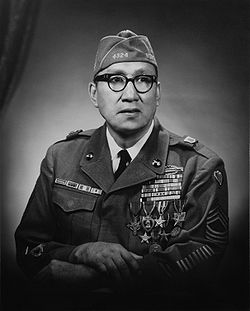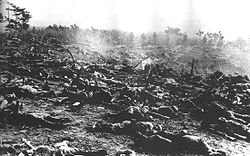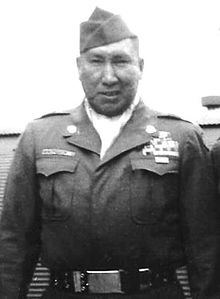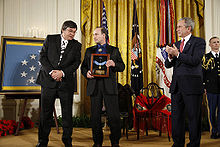- Woodrow W. Keeble
-
Woodrow W. Keeble 
MSgt Woodrow W. Keeble, Medal of Honor recipientBorn May 16, 1917
Waubay, South DakotaDied January 28, 1982 (aged 64) Place of burial Sisseton, South Dakota Allegiance  United States of America
United States of AmericaService/branch United States Army Years of service 1941 - 1953 Rank Master Sergeant Battles/wars Korean War Awards  Medal of Honor
Medal of Honor
 Distinguished Service Cross
Distinguished Service Cross
 Silver Star
Silver Star
 Bronze Star with "V" attachment for Valor
Bronze Star with "V" attachment for Valor
 Purple Heart (2)
Purple Heart (2)Master Sergeant Woodrow Wilson Keeble (May 16, 1917 - January 28, 1982) was a U.S. Army National Guard veteran of both World War II and the Korean War. He was a full-blooded member of the Sisseton Wahpeton Oyate of the Lake Traverse Reservation, a Sioux Native American tribe.
Following a long campaign by his family and the congressional delegations of both North and South Dakota, on March 3, 2008, President George W. Bush posthumously awarded Keeble the Medal of Honor for his actions in the Korean War. Keeble had previously been awarded the Distinguished Service Cross, the Silver Star, the Bronze Star with V device for Valor, the Bronze Star for merit, and the Combat Infantryman Badge (first and second awards). Although he was wounded at least twice in World War II and three times in Korea, he received only two Purple Hearts.
Contents
Early life
Woodrow Keeble was born in Waubay, South Dakota to Isaac and Nancy (Shaker) Keeble on May 16, 1917. While still very young, he moved to Wahpeton, North Dakota, where his mother worked at the Wahpeton Indian School (now called Circle of Nations School). Unfortunately, Nancy died when Keeble was still a child. Keeble's father, who was too impoverished to feed his family, permanently enrolled Woodrow and his siblings in the school.
Woodrow excelled in athletics, especially baseball, and pitched the Wahpeton amateur team to ten straight victories. He was being recruited by the Chicago White Sox when his Army National Guard unit was called up to serve in World War II.
World War II
In World War II, Keeble served with I Company of the famed North Dakota 164th Infantry Regiment. After initial training in Louisiana, the regiment carried out various orders in several West Coast locations before being deployed to Australia in preparation for operations in the Pacific Theater. Keeble's unit was assigned to the Americal Division.
The 164th landed on Guadalcanal on October 13, 1942 to help the battered First Marine Division, which had suffered heavy losses while clearing the South Pacific island of Japanese. The 164th provided the first replacements for the 1st Marines, and although the new boys were green, the exhausted men heartily welcomed the North Dakotans—and their supplies.
Keeble's regiment of Dakotans was the first United States Army unit to conduct an offensive operation against the enemy in any theater.
Largely because of transport constraints, the Americal Division arrived on Guadalcanal piecemeal, and was fed into combat alongside the battle-hardened Marines. Thus, in contrast to how several US Army divisions were deployed in the Pacific War, the soldiers of the 164th Infantry were able to learn the practical art of jungle warfare against the Japanese without suffering as many casualties as might otherwise have occurred.
The battles on Guadalcanal were some of the most brutal of the war. Japanese troops adopted the Banzai charge, wildly attacking in human waves. Sometimes the hand-to-hand battles would last all through the night.
During these battles, Keeble's reputation for bravery and skill grew. Nearly a head taller than most of his fellow soldiers, he was an expert with the Browning Automatic Rifle (BAR). His other great weapon was his pitching arm, which he used to hurl hand grenades with deadly accuracy. James Fenelon, a member of the Standing Rock Sioux Tribe of North & South Dakota who fought with Keeble on Guadalcanal, once remarked, “The safest place to be was right next to Woody.”[1]
Despite its ad-hoc formation, the Americal Division fought well at Guadalcanal, the 164th taking on a key role in the defeat of a major Japanese offensive in October 1942. Uniquely, the North Dakotans performed so heroically on Guadalcanal in support of the Marines that they received a Navy Presidential Unit Citation.
After the battles on Guadalcanal, Keeble and the rest of the regiment participated in combat campaigns on the islands of Bougainville, Leyte, Cebu, and Mindanao. Following the Japanese surrender, the entire Americal Division landed in Japan and took part in the occupation of the Yokohama region.
After the war, Keeble returned to Wahpeton and worked at the Wahpeton Indian School. On November 14, 1947, Woodrow Wilson Keeble married Nettie Abigail Owen-Robertson (b. March 30, 1917).
Woodrow Keeble on combat
Examining the experience of being in combat for the first time, Keeble explained,
Before I experienced the horror of that attack, I was quick to call coward or yellow anyone who showed fear under any circumstances. Nevermore. I don’t know these things, but they speak truth to one. I am not a psychologist, nor a statistician, and less of a philosopher; but the depth of emotion, the dreads of fear, the referees of horrors, and the concentration of self that led me to make this observation, the fear impulse, or perhaps, better said, the (impulses caused) by fear, are stronger, more demanding than either that of love or hunger...
He also wrote:
Fear in my opinion is a state of drunkenness. And when men are in that state when the fear impulse takes a hold...he loses all reason, sense of values, and is not liable, or at least should not be held accountable for acts perpetrated when thus possessed.
Keeble continued:
During the 13 months (in the) almost continual and sustained combat in which I have ever participated, there were moments, and rare ones, I am sure; but they lose none of their terror or horror for which fear laid a relentless and a powerful hold on me, that the pull of cowardice was almost more than I could ward off. There were terrible moments that encompassed a lifetime, an endlessness, when terror was so strong in me, that I could feel idiocy replace reason. (Yet,) I have never left my position, nor have I shirked hazardous duty. Fear did not make a coward out of me.[2]
Korean War
The 164th Infantry Regiment was reactivated in 1951 during the Korean War; they trained at Camp Rucker, Alabama. When Keeble's commanding officer, Lt E. Duane Holly, had to select several sergeants for deployment to the front lines, he decided to have his men draw straws. Keeble volunteered instead. Asked why, Keeble said, “Somebody has to teach these kids how to fight.”
Keeble was assigned to George Company, 2nd Battalion, 19th Infantry Regiment, 24th Infantry Division. His combat experience and a genuine gift of leadership brought him a quick series of promotions to the level of master sergeant, leading the 1st Platoon.
The summer and fall of 1951 were particularly deadly for both sides as the war moved into its second year. The 24th Division was in the central area of the Korean peninsula when, on October 13, 1951, the Division was called upon to take a series of steep mountains protecting a major Chinese supply depot in the town of Kumsong.
This push, Operation Nomad-Polar, was to be the last major United Nations offensive of the war.
Keeble, described as a gentle giant by his friends, was a ferocious warrior in battle, as evidenced by his heroic actions over the next six days. Official records confirm Keeble was initially wounded on October 15, and then again on October 17, 18 and 20 - for which he received only one Purple Heart. For his bravery on the 18th, he was awarded a Silver Star. His heroism on the 20th made Keeble a legend - and 57 years later resulted in his posthumous Medal of Honor.
George Company was in its sixth day of round-the-clock fighting. They were facing deeply entrenched Chinese soldiers on Hill 675-770, the last major Chinese stronghold between the UN forces and Kumsong. Keeble had thus far suffered two rifle wounds to his left arm, a grenade to his face that almost removed his nose and a badly twisted knee; on the 19th, doctors reportedly removed 83 pieces of festering shrapnel Keeble had sustained from a concussion grenade the previous day. On the 20th, Medic Dale Selby told Keeble he should stay back because of his wounds, but Keeble refused to let his men go up the mountain without him. That day, Master Sergeant Keeble single-handedly destroyed three enemy machine-gun bunkers and killed an additional seven enemy soldiers in nearby trenches.
His bravery in the face of enemy fire was so remarkable that a recommendation that he receive the Medal of Honor was twice submitted. In both cases, the recommendation was lost. When Keeble's men endeavored to submit the recommendation a third time, officials informed them they were too late; they were told regulations prevented them from submitting another recommendation.
Later life
Master Sergeant Keeble returned to North Dakota after the Korean War and again worked at the Wahpeton Indian School. Soon after, he was afflicted with tuberculosis, which required that he undergo long-term treatment in Minneapolis, Minnesota. Surgeons ultimately removed one of his lungs, which triggered a series of strokes that rendered him speechless, partially paralyzed and unable to work for the remainder of his life. Nettie, his wife of 14 years, died the following year, leaving Keeble to raise their young son, Earl, alone.
Keeble fell on hard times and is said to have pawned his medals. Nevertheless, and despite his disabilities, Keeble persevered. In 1967, he married Blossom Iris Crawford-Hawkins (b. July 18, 1926), the first Sioux woman to complete a Doctorate of Education, (including doctoral dissertation).
Woodrow Keeble was a member of the Veterans of Foreign Wars (VFW) Post 4324 - Wahpeton, ND.
Woodrow W. Keeble died January 28, 1982, and is buried in Sisseton, South Dakota. On May 17, 2008, his tombstone was replaced with a Medal of Honor headstone.
Medal of Honor campaign
Keeble's family and friends remained dedicated to efforts to get him the Medal of Honor for which he was twice recommended. United States Senators Byron Dorgan (D-N.D.), Kent Conrad (D-N.D.) John Thune (R-S.D.) and Tim Johnson (D-S.D.) long urged that Keeble be posthumously awarded the Medal of Honor.
Senator Conrad and North Dakota Adjutant General Michael Haugen presented Keeble's family with a duplicate set of his medals on May 30, 2006, at the Wahpeton Armory. Moments before the event was to begin, word came that Secretary of the Army Francis Harvey was recommending Keeble's Distinguished Service Cross be upgraded to the Medal of Honor. From there, Keeble's case moved up to the level of Secretary of Defense.
In 2007, Secretary of Defense Donald Rumsfeld, notified the four Dakota Senators that a statute of limitations would prevent the Medal of Honor to be granted. The four Dakota Senators immediately drafted legislation to remove the last barrier to the posthumous awarding of the honor.
In May 2007, the congressional funding bill for Iraq included language to grant a waiver of the statute of limitations for awarding a Medal of Honor to Woodrow W. Keeble, enabling the President to sign off on the recommendation, dependent on the Secretary of Defense's recommendation for the upgrade. President Bush signed the legislation on May 24, 2007.
Senator Thune issued a statement on June 2 that read, in part,
Master Sergeant Woodrow W. Keeble served with bravery and dignity, going beyond the call of duty not for notoriety or recognition-but for the mission he believed in and the country he loved. Keeble's legacy is a great source of pride for his family, his fellow Dakota Sioux, and all Americans. The Secretary of the Army's recommendation is wonderful and long-awaited news. I began working with Master Sergeant Keeble's family and tribal officials on resolving this long overdue issue in the spring of 2002, and I will continue to work with Defense officials to ensure that this legendary soldier receives the final and most distinguished honor he deserves.
Senator Johnson urged Secretary of Defense Robert M. Gates to act quickly on the recommendation. “... it is my hope that both you and the President can move forward on Master Sergeant Keeble’s case as expeditiously as possible,” Johnson said in a letter to Gates quoted in the Argus Leader of Sioux Falls, South Dakota.
It would be another year before the President would finally award the Medal of Honor to Keeble. Despite failing health, Blossom Keeble was determined to live long enough to accept the Medal of Honor on her husband's behalf. Unfortunately, she died quite suddenly on June 3, 2007 before the honor became a reality.
In February 2008, the White House announced that Keeble would receive the Medal of Honor posthumously in a ceremony scheduled for March 3. "We are just proud to be a part of this for Woody," Keeble's stepson Russell Hawkins said in a U.S. Army announcement. "He is deserving of this, for what he did in the Armed Services in defense of this country."
Hawkins added that this victory is as important for the Sisseton-Wahpeton tribe and North and South Dakota as it is for Keeble and his family. "We are all extremely proud that Woody is finally receiving this honor. He epitomized our cultural values of humility, compassion, bravery, strength and honor."
Hawkins added that Keeble was the embodiment of woyuonihan ("honor"), always carrying himself in a way so that those who knew him would be proud of him. "He lived a life full of honor and respect."
Hawkins said his feelings about Keeble echo those of all who knew him. "If he was alive today, I would tell him there's no one I respect more, and how he is everything a man should be: brave, kind and generous. I would tell him how proud I am of him, and how I never realized that all this time, I was living with such greatness."[3]
Medal of Honor citation
The President of the United States of America, authorized by Act of Congress, March 3, 2008, has awarded in the name of Congress the Medal of Honor to:
Master Sergeant Woodrow W. Keeble United States Army
Citation:
For conspicuous gallantry and intrepidity at the risk of his life above and beyond the call of duty: Master Sergeant Woodrow W. Keeble distinguished himself by acts of gallantry and intrepidity above and beyond the call of duty in action with an armed enemy near Sangsan-ni, Korea, on October 20, 1951. On that day, Master Sergeant Keeble was an acting platoon leader for the support platoon in Company G, 19th Infantry, in the attack on Hill 765, a steep and rugged position that was well defended by the enemy. Leading the support platoon, Master Sergeant Keeble saw that the attacking elements had become pinned down on the slope by heavy enemy fire from three well-fortified and strategically placed enemy positions. With complete disregard for his personal safety, Master Sergeant Keeble dashed forward and joined the pinned-down platoon. Then, hugging the ground, Master Sergeant Keeble crawled forward alone until he was in close proximity to one of the hostile machine-gun emplacements. Ignoring the heavy fire that the crew trained on him, Master Sergeant Keeble activated a grenade and threw it with great accuracy, successfully destroying the position. Continuing his one-man assault, he moved to the second enemy position and destroyed it with another grenade. Despite the fact that the enemy troops were now directing their firepower against him and unleashing a shower of grenades in a frantic attempt to stop his advance, he moved forward against the third hostile emplacement, and skillfully neutralized the remaining enemy position. As his comrades moved forward to join him, Master Sergeant Keeble continued to direct accurate fire against nearby trenches, inflicting heavy casualties on the enemy. Inspired by his courage, Company G successfully moved forward and seized its important objective. The extraordinary courage, selfless service, and devotion to duty displayed that day by Master Sergeant Keeble was an inspiration to all around him and reflected great credit upon himself, his unit, and the United States Army.
Additional honors
On March 17, 2008, the South Dakota Governor Mike Rounds, before a joint session of the State Congress, officially proclaimed the date to be forever commemorated as Woodrow Wilson Keeble Day in the state of South Dakota.
On July 23, 2008, North Dakota Governor John Hoeven posthumously presented Keeble with the Theodore Roosevelt Rough Rider Award, The award recognizes present or former North Dakotans who achieve national recognition in their fields of endeavor.[5]
In addition to these awards, numerous regional sites also pay homage to the memory of Woodrow Keeble. A section of U.S. Highway 12 near Keeble's birthplace in Waubay, South Dakota, is named in his honor. A special shelter in Chahinkapa Park in Wahpeton was built in his honor. Previous to the Medal of Honor ceremony, the gymnasium at the Wahpeton Indian School, now called the Circle of Nations School, was named for him. In May 2008, the school celebrated its 100th anniversary and named a new dormitory for Keeble. The State of North Dakota erected a Medal of Honor Memorial in Roosevelt Park in Minot. North Dakota has more Medal of Honor recipients, per capita, than any other state. A separate pillar was built for Woodrow Keeble. It was dedicated during a special celebration on July 4, 2008. A new Armed Forces Reserve Center in Sioux Falls has also been named for Keeble.
See also
References
- ^ Merry Helm, Dakota Datebook. Prairie Public Radio May 16, 2005
- ^ Merry Helm, Dakota Datebook. Prairie Public Radio 16 May 2005
- ^ First Sioux to Receive Medal of Honor, US Army press release, February 22, 2008
- ^ U.S. Army Medal of Honor citation
- ^ North Dakota Theodore Roosevelt Rough Rider Award citation July 23, 2008
External links
- "Korean War Hero Receives Posthumous Medal of Honor (Defenselink News Article)". http://www.defenselink.mil/news/newsarticle.aspx?id=49159.
- "First Sioux receives Medal of Honor (CNN Video)". March 4, 2008. http://www.cnn.com/2008/POLITICS/03/03/medal.of.honor/index.html#cnnSTCVideo.
- "Medal of Honor site - Master Sergeant Woodrow W. Keeble". http://www.army.mil/medalofhonor/keeble.
- "First Sioux to Receive Medal of Honor, US Army press release, February 22, 2008". http://www.army.mil/-news/2008/02/22/7566-first-sioux-to-receive-medal-of-honor/.
- ""Master Sergeant Keeble, Hero" Prairie Public Radio, May 16, 2005". http://www.prairiepublic.org/programs/datebook/bydate/05/0505/051605.jsp.
- ""Mission of honor: Woman’s efforts help get Medal of Honor awarded to ‘Woody’ Keeble" Minot Daily News, April 7, 2008". http://www.minotdailynews.com/page/content.detail/id/513786.html.
- ""Most Decorated Soldier" Prairie Public Radio, October 20, 2005". http://www.prairiepublic.org/programs/datebook/bydate/05/1005/102005.jsp.
- "Dorgan and Johnson Announce Legislation to Honor Woodrow Wilson Keeble". http://johnson.senate.gov/record.cfm?id=272874.
- "Johnson urges Bush to approve medal, August 16, 2007". http://www.argusleader.com/apps/pbcs.dll/article?AID=200770815030.
- "A Humble Thanks to a Deserving Soldier (Senator Tim Johnson)". http://johnson.senate.gov/~johnson/releases/200602/2006214B01.html.
- "President's Remarks". http://www.army.mil/medalofhonor/keeble/citation/president.html.
Categories:- Army Medal of Honor recipients
- Native American United States military personnel
- Sioux people
- United States Army soldiers
- Recipients of the Distinguished Service Cross (United States)
- Recipients of the Silver Star
- Recipients of the Purple Heart medal
- Recipients of the Combat Infantryman Badge
- American military personnel of World War II
- American military personnel of the Korean War
- 1917 births
- 1982 deaths
- Deaths from stroke
Wikimedia Foundation. 2010.



